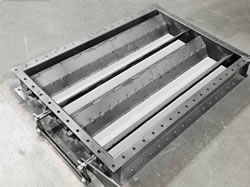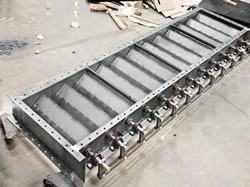Ventilation Dampers
Heavy Duty Industrial Dampers
Draft-Air low leakage Damper represents a new standard for industrial air control dampers. The frame is made from heavy gauge galvanized sheet & blade made of extruded aluminum section. PVC linkages are provided for automatic operation. Dampers can be tailor made to suit site requirements. Option is also available with Galvanized blades for manual operation. As a standard the blades are opposed but can be made parallel as per requirement for general ventilation purpose.

For fans with inlet box dampers differ from the IVC in that the bearings are outside the airstream, allowing for higher temperatures and dust laden applications. For installations in excess of 200°F, dampers rotate through long life pillow block bearings mounted on stand-off channels, and protected by stuffing boxes with braided fibrous packing to prevent leakage at the shaft holes in the frame. Blades, axles and frames can be coated with any number of coatings, or constructed of mild steel, or 304 and 316 stainless steels.
Inlet Volume Control (IVC)

The Inlet Volume Control (IVC) is a device designed by Chicago Blower to alter fan performance. Closing the IVC spins inlet air in the direction of the wheel rotation and reduces the flow and pressure while traveling down the fan's system curve. This keeps the fan in a stable operating condition. Chicago's IVCs can be utilized on open inlet fans, as well as fans with inlet boxes.

Chicago's IVC consists of 7 or 9 pie-shaped blades nested inside an inlet cone, welded to full length axles. These pivot on prelubricated bronze bearings located within a covered operating mechanism positioned in the center of the inlet cone. IVCs are furnished for manual control with a locking quadrant or for automatic operation using an electric or pneumatic actuator. On double inlet fans, interconnecting linkage assures coordinated operation.
Standard IVCs are suitable for applications to 200°F. They should not be considered zero leakage. An optional low-leakage IVC has tighter clearances resulting in additional turn-down capabilities.
Outlet Damper

Outlet dampers are primarily utilized for shut-off and isolation, but can also assist in achieving greater turndown when combined with an IVC or inlet damper. They are not recommended as the primary modulation damper as the closure of these dampers alter the system curve, moving it towards the peak pressure point and resulting in an unstable condition. The damper has double surfaced blades welded to full length axles. The blades rotate with an opposed action to each other, thereby creating a straight air flow. The blades are fully contained within a heavy-duty, formed steel channel frame sized to match the fan discharge, evase ́ or stack opening. The shafts rotate through the flanged bearings. For installations in excess of 200°F, dampers rotate through long life pillow block bearings mounted on stand-off channels, and protected by stuffing boxes with braided fibrous packing to pre- vent leakage at the shaft holes in the frame. Blades, axles and frames can be coated with any number of coatings, or constructed of mild steel, or 304 and 316 stainless steels depending on the temperature and application.
Pre-spin Inlet Box Damper

The objective to alter fan performance is similar to the IVC. Double surfaced blades are welded to full length axles and open and close parallel to each other. When partially closed, flow and pressure is reduced as the blades pre-spin the air into the fan with the same rotation as the wheel. Louvered blades are fully contained within a heavy-duty, formed steel channel frame with the axles parallel to the fan shaft.
Opposed Blade Inlet Damper
In certain applications, fans are equipped with opposed bladed fresh air inlet dampers. When closed, the blades provide for a straight flow of air towards the fan. These dampers are typically used in boiler applications, and help to induce recirculated flue gas (FGR) back into the fan’s inlet airstream by creating a back pressure.
Both types of inlet box dampers differ from the IVC in that the bearings are outside the airstream, allowing for higher tempera- tures and dust laden applications. For installations in excess of 200°F, dampers rotate through long life pillow block bearings mounted on stand-off channels, and protected by stuffing boxes with braided fibrous packing to prevent leakage at the shaft holes in the frame. Blades, axles and frames can be coated with any number of coatings, or constructed of mild steel, or 304 and 316 stainless steels.
Butterfly Dampers

Butterfly dampers are used for control and isolation of various gases in round ducts. They can be made to match standard or ANSI flanges ranging from 12" to 48" openings. A heavy single thickness blade is welded to a heavy stub shaft. The shaft rotates through long life flanged bearings mounted on stand-off channels. Openings are protected by stuffing boxes with braided fibrous packing to prevent leakage at the shaft holes in the frame. Blades, axles and frames can be coated with any number of coatings, or constructed of mild steel, or 304 and 316 stainless steels depending on the temperature and application.

